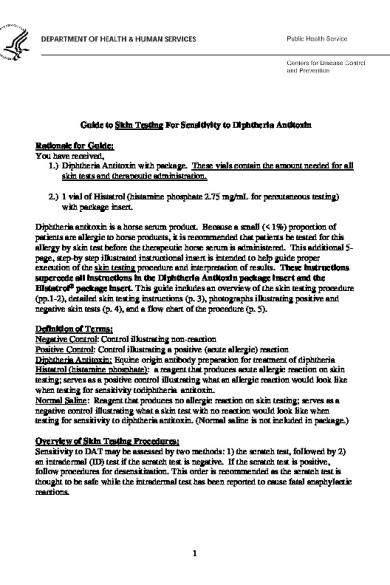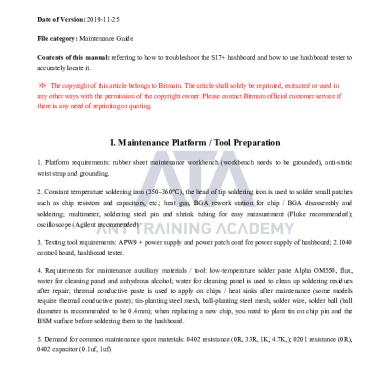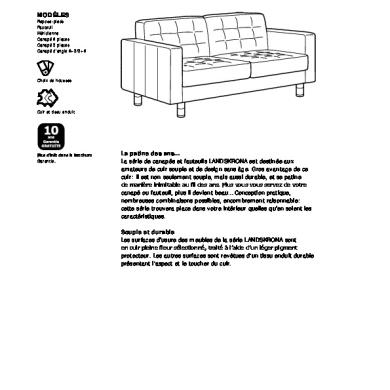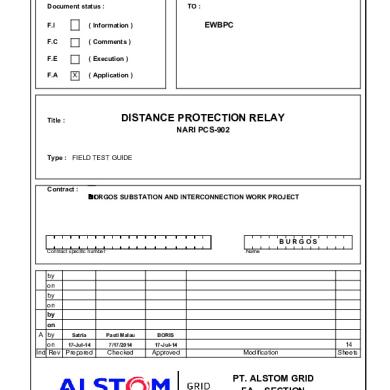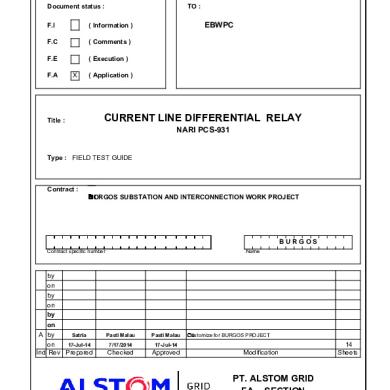* The preview only shows a few pages of manuals at random. You can get the complete content by filling out the form below.
Description
Guide to Skin Testing For Sensitivity to Diphtheria Antitoxin Rationale for Guide: You have received, 1.) Diphtheria Antitoxin with package. These vials contain the amount needed for all skin tests and therapeutic administration. 2.) 1 vial of Histatrol (histamine phosphate 2.75 mg/mL for percutaneous testing) with package insert. Diphtheria antitoxin is a horse serum product. Because a small (< 1%) proportion of patients are allergic to horse products, it is recommended that patients be tested for this allergy by skin test before the therapeutic horse serum is administered. This additional 5page, step-by step illustrated instructional insert is intended to help guide proper execution of the skin testing procedure and interpretation of results. These instructions supercede all instructions in the Diphtheria Antitoxin package insert and the Histatrol® package insert. This guide includes an overview of the skin testing procedure (pp.1-2), detailed skin testing instructions (p. 3), photographs illustrating positive and negative skin tests (p. 4), and a flow chart of the procedure (p. 5). Definition of Terms: Negative Control: Control illustrating non-reaction Positive Control: Control illustrating a positive (acute allergic) reaction Diphtheria Antitoxin: Equine origin antibody preparation for treatment of diphtheria Histatrol (histamine phosphate): a reagent that produces acute allergic reaction on skin testing; serves as a positive control illustrating what an allergic reaction would look like when testing for sensitivity to diphtheria antitoxin. Normal Saline: Reagent that produces no allergic reaction on skin testing; serves as a negative control illustrating what a skin test with no reaction would look like when testing for sensitivity to diphtheria antitoxin. (Normal saline is not included in package.) Overview of Skin Testing Procedures: Sensitivity to DAT may be assessed by two methods: 1) the scratch test, followed by 2) an intradermal (ID) test if the scratch test is negative. If the scratch test is positive, follow procedures for desensitization. This order is recommended as the scratch test is thought to be safe while the intradermal test has been reported to cause fatal anaphylactic reactions.
1
Epinephrine Hydrochloride Solution (1:1000) and other appropriate agents must be available for immediate use in case an anaphylactic or acute hypersensitivity reaction occurs. In addition, the patient should be placed in a comfortable position during the tests and the test areas should be cleaned with alcohol before testing. You will perform skin tests using the left arm for the controls (saline and histamine phosphate) and the right arm for the test (Diphtheria Antitoxin): 1. Normal saline as the negative control (left arm) 2. Histamine phosphate 2.75mg/mL as the positive control (left arm) 3. Diphtheria Antitoxin at 1:100 dilution* (right arm) (prepared by diluting 0.1 mL antitoxin serum in 10mL normal saline) * Use a 1:1,000 dilution in patients with a positive history for animal allergy or prior exposure to animal serum. A scratch test is performed by making a small scratch in the skin and placing a small drop of the solution to be tested on the site of the scratch. An intradermal test is performed by administering a small amount of solution intradermally until a small wheal develops.
Interpretation of Scratch Test Results: Photographs are provided in this guide (p. 3) to assist with interpretation of the results. • • •
If the test arm (right arm) reaction looks like the negative control (normal saline), then the patient has no allergic reaction and may proceed to intradermal test. If the test arm (right arm) reaction looks like the positive control (Histamine Phosphate), then the patient is allergic and must undergo desensitization before treatment (See desensitization protocol below). If the test arm (right arm) reaction is equivocal, the patient must undergo desensitization before treatment (See desensitization protocol below).
2
3
PROCEDURE: SCRATCH TEST STEP A.
ILLUSTRATION
Clean skin site on the volar surface of the patient’s left and right forearm with alcohol and air dry.
B.
Negative Skin Test Control—Saline Solution (left arm) a. Carefully scratch the skin approximately 2 mm-4 mm in length with a sterile needle (27 gauge) without drawing blood. b. Place a small drop of normal saline on the site of the scratch. c. Read the test at 15 minutes; no reaction should occur
C.
Positive Skin Test Control- Histamine (Histatrol) (left arm) a. Choose a site on the arm at least 5 cm from any other test site. Carefully scratch the skin approximately 2 mm-4 mm with a sterile needle (27 gauge) without drawing blood. b. Using dropper from Histatrol vial (Histamine Phosphate 2.75 mg/mL for percutaneous testing), place a small drop of Histatrol on the site of the scratch. c. Read the test at 15 minutes; a positive scratch test is a wheal with surrounding erythema at least 3 mm larger than the negative control test, read at 15-20 minutes. if a large wheal reaction occurs before that time, the test site should be wiped free of histamine
D.
Diphtheria Antitoxin Testing (right arm) a. Dilute 0.1 mL diphtheria antitoxin in 10 mL normal saline to make a 1:100 dilution of diphtheria antitoxin serum. Use a 1:1,000 dilution in patients with a positive history for animal allergy or prior exposure to animal serum. b. Choose a site on the arm at least 5 cm from any other test site. Carefully scratch the skin approximately 2 mm-4 mm in length with a sterile needle (27 gauge) without drawing blood. c. Place a small drop of a 1:100 dilution of the diphtheria antitoxin serum in normal saline on the site of the scratch. In patients with a positive history for animal allergy or prior exposure to animal serum, apply one drop of a 1:1,000 dilution of the serum in normal saline to the site. If the test is negative, repeat it using a 1:100 dilution. d. Read the test at 15 minutes; no reaction should occur. A positive scratch test is a wheal with surrounding erythema at least 3 mm larger than the negative control test, read at 15-20 minutes. A reaction indicates the patient is allergic and requires desensitization. An equivocal skin test is a noticeable wheal but <3 mm larger than the negative control test, read at 15-20 minutes.
4
Saline Scratch Diphtheria Antitoxin Scratch Histamine Scratch
EXPLANATION OF RESULTS (see Flow Chart on page 8) If the patient has a negative skin test (Diphtheria Antitoxin test site on right arm looks like the Saline Solution test site on left arm), proceed to intradermal test. If the patient has a positive or equivocal skin test (Diphtheria Antitoxin test site on right arm looks like the Histamine (HISTATROL) test site on left arm), patient requires desensitization before administering dose of antitoxin. If patient experiences a systemic reaction (e.g., hypotension, respiratory distress, generalized rash) administer epinephrine as necessary. See desensitization protocol below. PROCEDURE: INTRADERMAL (ID) TEST STEP A.
ILLUSTRATION
Clean skin site on the volar surface of the patient’s left and right forearm with alcohol and air dry.
B.
Negative Skin Test Control—Saline Solution (left arm) a. Administer 0.02 ml normal saline intradermally using a 26-28 gauge sterile needle. This dose should raise a small ID wheal. b. Read the test at 15 minutes; no reaction should occur
C.
Positive Skin Test Control- Histamine (Histatrol) (left arm) a. Administer 0.02 ml Histatrol (Histamine Phosphate 2.75 mg/mL for percutaneous testing) intradermally using a 26-28 gauge sterile needle. This dose should raise a small ID wheal. b. Read the test at 15 minutes; a positive ID test is a wheal with surrounding erythema at least 3 mm larger than the negative control test, read at 15-20 minutes. If a large wheal reaction occurs before that time, the test site should be wiped free of histamine.
D.
Diphtheria Antitoxin Testing (right arm) a. Dilute 0.1 mL diphtheria antitoxin in 10 mL normal saline to make a 1:100 dilution of diphtheria antitoxin serum. Use a 1:1,000 dilution in patients with a positive history for animal allergy or prior exposure to animal serum. b. Choose a site on the arm at least 5 cm from any other test site. c. Administer 0.02 ml of a 1:100 dilution of the diphtheria antitoxin serum in normal saline intradermally using a 26-28 gauge sterile needle. This dose should raise a small ID wheal. In patients with a positive history for animal allergy or prior exposure to animal serum, administer 0.02 ml of a 1:1,000 dilution of the serum in normal saline intradermally. If the test is negative, repeat it using a 1:100 dilution. d. Read the test at 15 minutes; no reaction should occur. A positive ID test is a wheal with surrounding erythema at least 3 mm larger than the negative control test, read at 15-20 minutes. A reaction indicates the patient is allergic and requires desensitization. An equivocal ID test is a noticeable wheal but <3 mm larger than the negative control test, read at 15-20 minutes.
5
Saline ID Diphtheria Antitoxin ID Histamine ID
EXPLANATION OF RESULTS (see Flow Chart on page 8) If the patient has a negative ID test (Diphtheria Antitoxin test site on right arm looks like the Saline Solution test site on left arm), Diphtheria antitoxin can be administered to the patient. If the patient has a positive or equivocal ID test (Diphtheria Antitoxin test site on right arm looks like the Histamine (HISTATROL) test site on left arm), patient requires desensitization before administering dose of antitoxin. If patient experiences a systemic reaction (e.g., hypotension, respiratory distress, generalized rash) administer epinephrine as necessary. See desensitization protocol below.
Desensitization Patients with positive sensitivity testing to DAT or with a history suggesting increased risk from DAT administration (even with a negative or equivocal sensitivity test) should undergo desensitization. Tables 1 & 2 serve as guides for desensitization. Table 1 gives an intravenous (IV) regimen and Table 2 gives intramuscular (IM), subcutaneous (SC) and intradermal (ID) regimens. The IV route is considered safer because it offers better control. The personnel performing desensitization need to have the expertise to treat anaphylaxis and the necessary equipment and medications available. Some physicians recommend concurrent treatment with an oral or IM antihistamine with or without IV administration of a corticosteroid such as hydrocortisone or methylprednisolone. The protection from anaphylaxis afforded by giving DAT according to the desensitization treatment schedule requires that no interruption occur in the sequence of administration of doses; if an interruption occurs the protection is lost. Table 1. Desensitization to DAT - Intravenous Route7 Dose Number*
Dilution of DAT in Normal Saline
Amount of Injection (cc)
1
1:1,000**
0.1
2
1:1,000
0.3
3
1:1,000
0.6
4
1:100**
0.1
5
1:100
0.3
6
1:100
0.6
7
1:10**
0.1
8
1:10
0.3
9
1:10
0.6
10
undiluted
0.1
11
undiluted
0.2
12
undiluted
0.6
13
undiluted 1.0 * Administer at 15 minute intervals.
6
**1 ml (antitoxin) + 9.0 ml of saline = 1:10 dilution 1 ml (1:10 dilution) + 9.0 ml of saline = 1:100 dilution 0.1 ml (1:10 dilution) + 9.9 ml saline = 1:1000 dilution [1 ml (1:100 dilution) + 9 ml saline = 1:1000 dilution]
Table 2. Desensitization to DAT - Intradermal, Subcutaneous and Intramuscular Route Dose Number*
Route of Administration
Dilution of DAT in Normal Saline
Amount of Injection (cc)
1
ID
1:1,000**
0.1
2
ID
1:1,000
0.3
3
SC
1:1,000
0.6
4
SC
1:100**
0.1
5
SC
1:100
0.3
6
SC
1:100
0.6
7
SC
1:10**
0.1
8
SC
1:10
0.3
9
SC
1:10
0.6
10
SC
undiluted
0.1
11
SC
undiluted
0.2
12
IM
undiluted
0.6
13
IM undiluted *Administer at 15-minute intervals. **1 ml (antitoxin) + 9.0 ml of saline = 1:10 dilution 1 ml (1:10 dilution) + 9.0 ml of saline = 1:100 dilution 0.2 ml (1:10 dilution) + 9.9 ml saline = 1:1000 dilution [1 ml (1:100 dilution) + 9 ml saline = 1:1000 dilution]
7
1.0
Flow Chart Insert for Diphtheria Antitoxin Administration Perform scratch test as described in text: A. Saline Solution B. Histamine C. DAT
- left arm - left arm - right arm
Result
Scratch Test: A. Saline Solution (left arm) = negative B. Histamine (left arm)
= positive YES
C. DAT (right arm)
= positive or equivocal
Positive or equivocal Scratch Test
Patient requires desensitization before administering therapeutic dose of DAT intravenously. If patient experiences a systemic reaction, treat as necessary.
Positive or equivocal Intradermal Test
Scratch Test: C. Saline Solution = negative (left arm) D. Histamine (left arm) E. DAT (right arm)
= positive
YES
Negative Scratch Test
Intradermal Test
Negative Intradermal Test
= negative Administer therapeutic dose of DAT
Scratch Test: = positive
A. Saline Solution (left arm)
YES
OR B. Histamine (left arm)
= positive
8
Indeterminate Scratch Test
Consider repeating procedure. Consult with diphtheria-on-call staff, Meningitis and VPD, CDC
